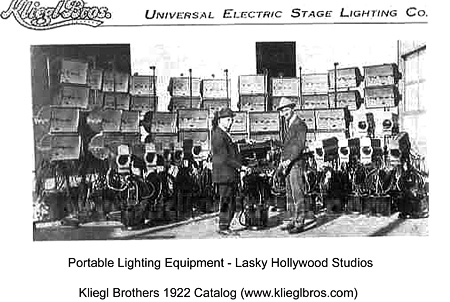What's a Klieg Light?

During the last week or so, there have been at least six mentions in the press of the phrase "Klieg lights," preceded by words such as "under," "in front of," "blinded by," "glare of," or "blasted with."
The intent of the reference seems to be to describe the environment of show business, to take the reader behind the scenes and to give one the feeling of being an "insider." The expression is not really part of the lexicon of people who actually do stage, film or TV entertainment lighting, but certainly is very common in the vocabulary of writers who report on the industry. Where in the world did this term "Klieg lights" come from, and what does it mean?
A LITTLE HISTORY
In the history of electric lighting, there is no "before the incandescent lamp." Yes, it started with Edison, a loop of carbon filament in a vacuum heated to a point that it glowed. It actually didn't glow too much, but since the benchmark was the light from a wax candle or a gas lamp, the results were accepted as revolutionary and as a technological breakthrough.
Meanwhile, in the back room of his laboratory, Edison, the "Genius of Menlo Park" as he was known, was developing a motion-picture device he called the "Kinetoscope." After the introduction of the Kinetoscope came that gradual but unstoppable development of motion pictures and the insatiable appetite of audiences for this entertainment product.
As you would expect, the film stock at the time left a lot to be desired. Not only did it need a lot of light (they built mammoth contraptions to rotate the scenery so it was properly faced toward the sun), but the film was not all that sensitive to red. Talk about under-exposed faces!
These early hardy pioneers also realized the necessity and convenience of a "studio." As a result, they needed a light source that could produce great amounts of light. At the time (early 1900s) not much was available. Certainly the incandescent sources were not in the running; they couldn't provide enough light.

Fig. 1: A photo from Kleigl Brothers' 1922 catalog Even in the beginning, it was recognized that direct, high-intensity lighting fixtures were required—as opposed to an uncontrolled wash of light from fixtures available in those very early days.
I cannot resist mentioning one of the early commercial light sources in the era of flooded illumination that was adapted to film studio use: the Cooper-Hewitt Mercury Vapor Arc Lamp. The name (which has quite a ring to it) is always hyphenated; in actuality, it was the invention of a man whose full name was Peter Cooper Hewitt, no hyphen.
The device was a quartz glass enclosed arc resulting from igniting mercury vapor. This very familiar-sounding technology gives rise to the observation that nothing is new, as we are talking 1905. In fact, the patents read like they were written yesterday, patent legalese being what it is.
I recall shooting one time at a studio in New York on the top of an old turn-of-the-century six-story commercial building and observing an electrical busway running through the studio. I was told by some ancient in attendance that they were used in the studio during the distant past to distribute power to Cooper-Hewitt fixtures. They were never removed in the fear that the fixtures may come back!
Actually, mercury vapor lamps did come back and enjoy some success for a short period after World War II in industrial-fixture applications, before being displaced by the metal halide lamp, a more sophisticated reworking of the mercury vapor lamp with greatly improved operation.
THE KLIEG LIGHT
The pioneers discovered the theatrical industry (as well as aircraft searchlights) used carbon arc sources that not only gave out a lot of light, but were contained in fixtures that allowed, at least in their limited experience, more control of beam.
In addition, again from their limited viewpoint, they were "automatic" and "portable." I date this breakthrough around 1912. The manufacturer of these arc fixtures was Kliegl Brothers Universal Stage Lighting Co. The amusing thing is that the term KliegLight was embossed on every fixture, whether arc or incandescent, and any type: floodlight, spotlight, music-stand light, etc.
As the early film industry production was in the New York area, the Kliegl brothers were right there to supply. The period of utilizing carbon arc sources of all sizes didn't last more than a few decades as larger incandescent "globes" became available—ones that were designed to fit new fixtures and resolve the problem of the inconvenience of the arc fixtures.
Fig. 1 shows a photo from the company's 1922 catalog, and certainly results in a very humbling feeling and appreciation for the skills of the lighting people of that era. One exception was the 225 amp "Brute" carbon arc from Mole-Richardson that remained with us for a much longer period because there was no equal to its size. It was eventually replaced by an equally large HMI lamp and fixture.
WHAT IS UNANSWERED?
What is amazing to me is that, during the apparently very short period in which it was utilized in film, the Klieg light received such an elevated status—and then refused to go away. There was one unit, the Kliegl Sun-Light, which was made in the 1930s and used the principle of the beam projector for producing a tight collimated beam.
I recall seeing similar fixtures on the shelf of Paramount's set-lighting shop as late as the 1980s. I remember being told that the light was very popular, had a lot of penetration and was a favorite for lighting "greens." (Shrubbery has a way of "eating" up light.)
Equally amazing is that the Kliegl brothers' fixtures were the accepted standard at the network—as well as at local television studios in New York—during the industry's onset. It was a very astute recognition by the offspring of the original Kliegl brothers that television would demand a lot of lighting fixtures. Sadly, these fixtures and the success of this old-line company were eclipsed by fixtures more applicable and of higher performance available from manufacturers of motion-picture lighting equipment, but the term "Klieg light" stayed.
THE REAL QUESTION
Now we are back to the original question: Why have we not progressed to a newer, more contemporary term to illustrate that we are in the special zone of entertainment lighting? Is the biggest problem that we can't really come up with a substitute that has the ring of "Klieg light"?
Trying out a few other names illustrates the problem: "A stellar opening night with Sky-Trackers;" "in the studio under the glare of a 10K and a 12x12;" "blasted by baby-babies;" or "blinded by 10,000 LEDs." Oh, dear. Maybe we'll just stick to "Klieg light" and be done with it.
Bill Klages would like to extend an invitation to all the lighting people out there to give him their thoughts at billklages@roadrunner.com.
Get the TV Tech Newsletter
The professional video industry's #1 source for news, trends and product and tech information. Sign up below.
